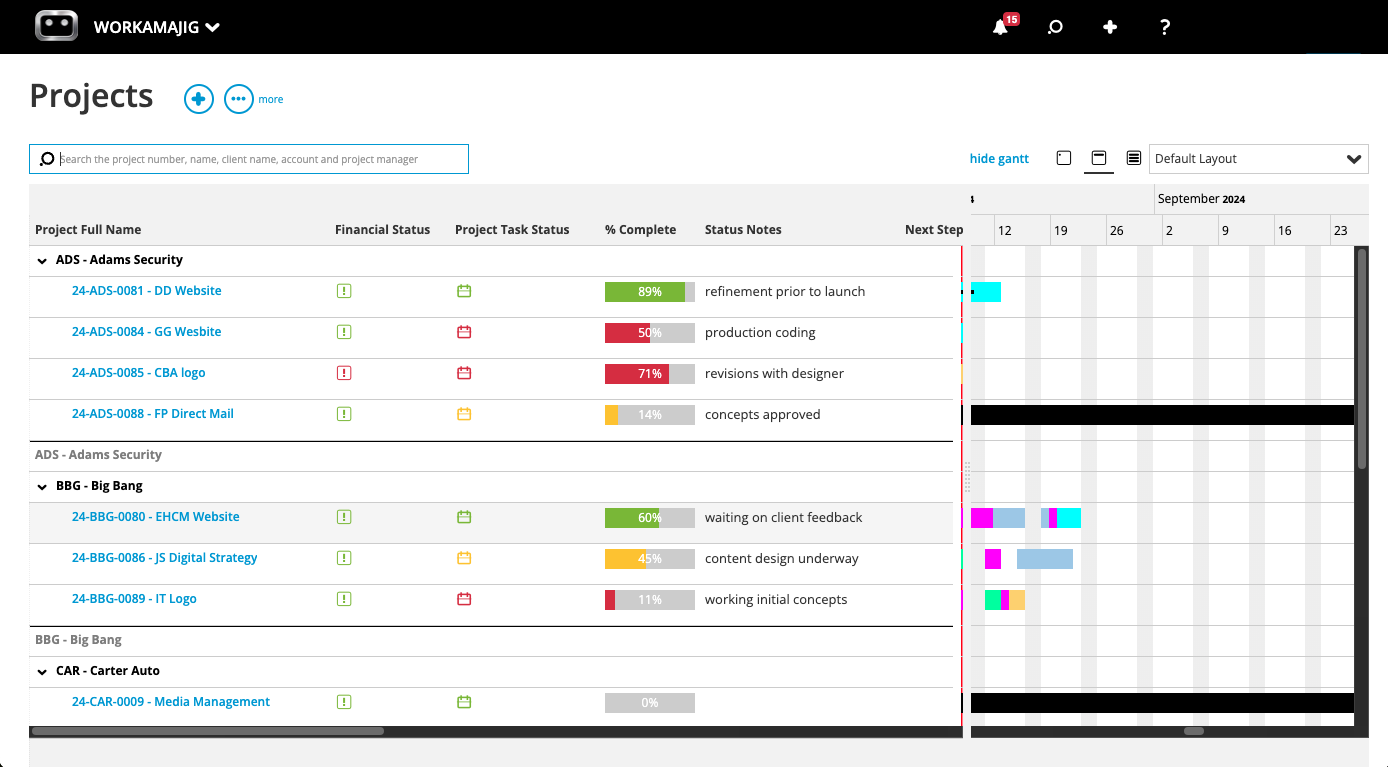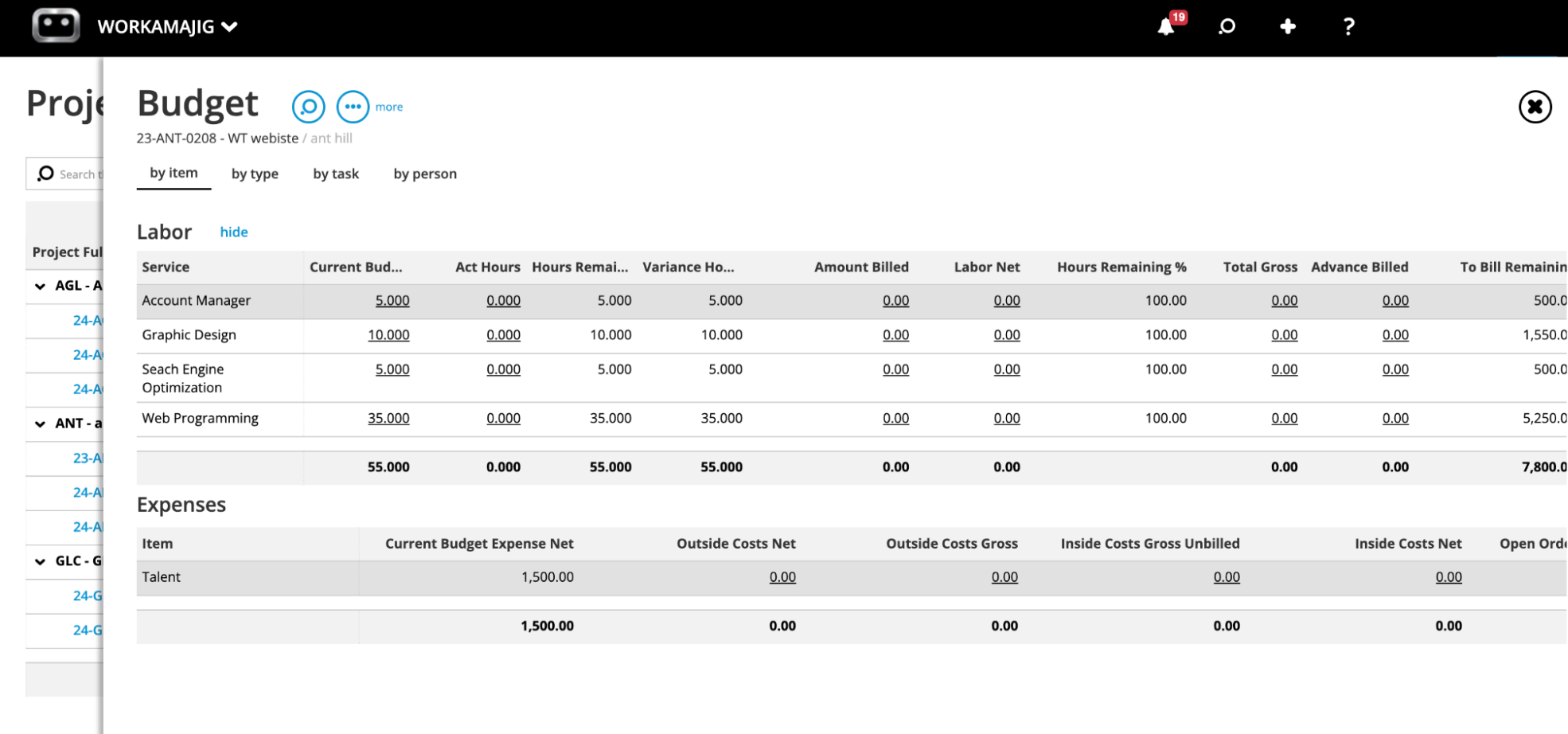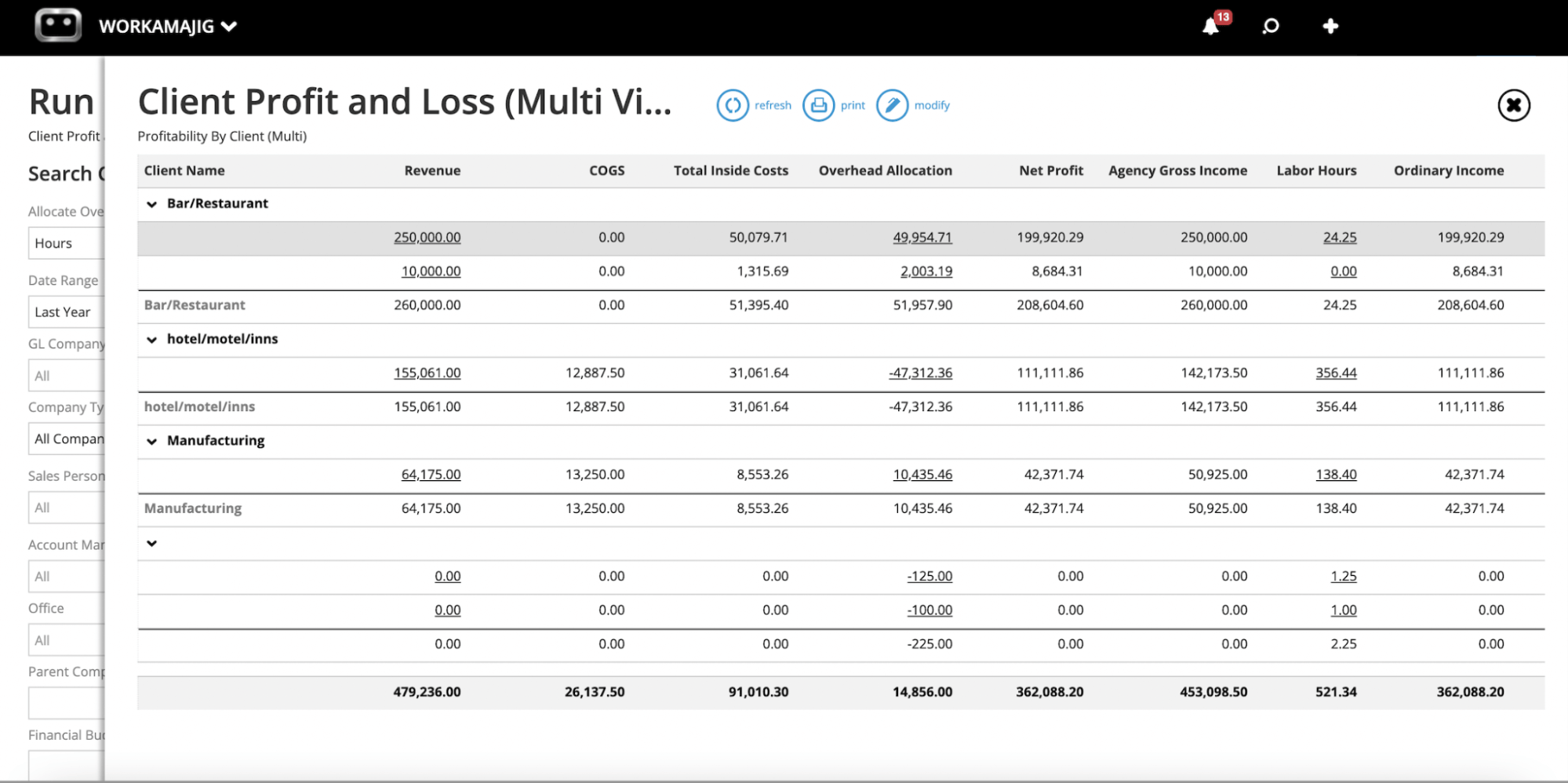Project cost management refers to planning, estimating, budgeting, financing, funding, and controlling a project's costs. It involves identifying all the costs associated with the project and creating a baseline, which serves as a reference point for monitoring and controlling costs throughout the project's lifecycle.
Small teams may estimate, record, and monitor project costs in spreadsheets — using templates, financial reports from previous projects, and tools like time-tracking software.
However, most (high-quality) project management software solutions include budget tracking and cost management modules to cover this component of successful project management.
The cost management tools in these solutions enable businesses to monitor and track expenses in the project workflow, identify inefficiencies or excessive spending areas, and make informed decisions to optimize spending.
Plus, by providing detailed insights and analytics, cost management tools help businesses control and reduce their expenses, ultimately leading to significant cost savings.
Workamajig is an agency and project management software developed for creatives' and marketers’ workflows — it combines project, resource, and budget management and includes business essentials like CRM, accounting software, and financial reporting dashboards.
We’ve created this guide to discuss creative cost management strategies and review different cost management tools. Specifically, it covers:
- Best practices for cost management
- Necessary project documents & elements for effective cost management
- Different types of project cost management tools
- Benefits of cost management tools
- Workamajig’s tools to support cost management
To learn more about our cost management solution, keep reading or schedule a free demo.
Best Practices for Effective Project Cost Management
Plan Cost Thresholds
Review past projects and consider your pricing structure to create cost thresholds for specific projects, project elements, or resource categories. These define how much your organization is willing to spend to complete specific project areas or deliver on requested work, and they specify the point at which managers need to take action to avoid exceeding threshold limits.
If, for example, your team decides to spend $1,000 on the design aspect of a brochure, the cost threshold should be below $1,000.
Then, if you reach this number before the brochure design is complete, managers will need to reevaluate project plans and costs to avoid pushing the entire project beyond the estimated budget.
Planning cost thresholds upfront reduces the need for last-minute evaluations and overspending.
Allocate Cost Control Roles
Put someone specifically in charge of overseeing the project budget. This ensures that someone frequently checks the project to ensure it stays within budget and employees know who to turn to if they run into budget-related issues.
Under-Promise & Over-Deliver
Besides being a fabulous technique for gaining client trust and likeability, under-promising and over-delivering on project scope puts you ahead of the budgeting game.
If you have your budget worked out so that you can afford a little more than what your client is expecting, rather than promising precisely what you can afford, you’ll have some leeway in the project expenses.
Then, if you run into budget trouble, you can always fall back on delivering less to your clients — they’ll never know that you had under-promised and were originally planning to deliver more!
Manage Scope Creeps with Change Orders
Scope creep can put you over budget because it pushes you to spend for resources you didn’t anticipate.
The solution? Cover unexpected costs that result from a shift in the client’s expectations with a change order. Once approved by the client, the additional funding should cover the extra work costs.
Consider Inflation & Secure Contingencies
Consider potential scenarios that could disrupt the budget plan when planning a project.
Inflation, for example, is a common cause of budget overrun, especially for extensive projects that take some time. Other things that could throw your project budget off balance include world events, weather changes, and natural disasters.
Plan for these and plan how you will adjust your budget accordingly.
Update Stakeholders with Status Reports
Run reports showing your performance and share them with your team and clients. Discuss reasons for variances between budgeted amounts and actuals to help foster accountability.
Project Elements for Effective Cost Management
Creative Brief
Defining your project’s scope and key objectives are the first steps toward creating a suitable budget; solid creative briefs help you do that.
By clarifying your strategies, you can be sure that you’re directing resources on the things that bring you closer to meeting project goals.
Baseline Project Budget & Spending Guidelines
Your project budget is the anticipated costs needed to implement your project plan and meet key objectives.
To create this, it’s helpful to review past projects and use a reliable template while aligning yourself with the current costs of relevant goods and services in the marketplace.
Establishing guidelines to know how much you can spend on any aspect of your project is also advisable.
You can read more about this here: The Creative Agency Guide to Creating a Project Budget
Work Breakdown Structure (WBS)
Organizing your team’s work into manageable sections with a work breakdown structure can help you accurately track project budgets by clarifying how you should allocate manpower resources.
Each task involved in a project typically comes at a cost. Identifying individual tasks that need to be completed can give project managers more insight into optimizing workflows and resources.
Resource Plan
Project managers must oversee several types of resources, such as labor, materials, and equipment. A resource plan allows you to make detailed budget plans; the more detailed your budget plan is, the easier it will be to stay on top of.
Preparing a resource plan is a good way to anticipate and avoid cost overruns for better project profitability.
Related read: The Complete Guide to Creative Resource Management
Project Dashboard
Consolidating relevant information in a project dashboard within project management software can help managers see how projects are performing relative to budgets at any point. This can help detect the need to make adjustments at crucial times to avoid putting out fires at the last minute.
Timesheets
Implement effective time-tracking methods like integrating schedules and timesheets through project budget management software.
Enabling your team to easily capture even the smallest amount of time spent on a task will help you monitor where efforts and energies are being allocated and course-correct on time if necessary.
Related read: Top Project Management Tools with Time Tracking
Types of Cost Management Tools Creatives Typically Require
The combination of budgeting, time tracking, reporting, and analytics tools significantly enhances cost management efforts for businesses in any industry.
-
Budgeting: This involves creating a financial plan that outlines expected revenues and expenses. By creating a budget, businesses can allocate resources efficiently and make informed spending decisions.
-
Time tracking: By accurately tracking the time spent on various tasks and projects, businesses can gain insights into where their resources are utilized and identify areas to reduce costs.
-
Financial reporting & analytics: Budget trackers and profitability reports enable businesses to monitor project costs, visualize and interpret data related to costs, identify patterns and trends that can inform cost management strategies, and calculate project ROI. These tools provide valuable insights into the organization's financial health and enable businesses to make informed decisions to maximize their resources.
Read more: Best Creative Project Management Tools with Financial Tracking
Benefits of Using Cost Management Tools
Avoid Overspending
Implementing cost management tools can help project managers gain better real-time visibility and control over project costs. This helps them make informed decisions and adjustments to keep costs in check throughout the project lifecycle.
Effective Planning
When project managers have access to cost management tools, they can accurately estimate the costs associated with a project. This allows them to plan and allocate resources more effectively, ensuring no financial surprises.
By clearly understanding the costs involved, project managers can make informed decisions and develop comprehensive plans that consider budget constraints, leading to more successful project outcomes.
Read more: 5 Steps to Creative Project Planning
Informed Decision-Making
When managing a project, it is crucial to have accurate and up-to-date information regarding costs.
Cost management tools also provide insights into the potential impact of changes in project scope or requirements on costs, enabling project managers to evaluate the feasibility and potential risks associated with such changes.
Exposes Opportunities for Operational Optimization
Cost management tools enable project managers to detect areas within the project that are incurring too much cost and can be streamlined. This allows them to identify inefficiencies or wasteful spending and initiate efforts to improve resource allocation.
Better Risk Management
When project managers clearly understand the costs involved in their decisions, they can accurately identify potential risks and develop contingency plans to mitigate them.
For example, if a particular task is expected to exceed the allocated budget, the project manager can proactively address the issue, such as renegotiating contracts or reallocating resources. This helps minimize financial risks and ensure the project stays on track.
Accurate Forecasts
Cost management tools provide project managers with a systematic approach to estimating and tracking project costs, allowing for more precise predictions of future expenses.
Cost management tools can help project managers anticipate potential cost overruns and make informed decisions to mitigate risks by analyzing historical data, current spending patterns, and other relevant factors.
With accurate cost forecasts, project managers can communicate effectively with stakeholders, ensuring transparency and trust throughout the project lifecycle.
Improves Visibility
By utilizing cost management tools, project managers can easily track the costs associated with a project and provide clear and concise reports for stakeholders. This increased visibility allows stakeholders to better understand the project's financial status and progress, enabling them to make informed decisions and provide valuable input.
Better Project Documentation
Cost management tools enable project managers to track and record all financial aspects of the project, including budgeting, expenses, and cost allocations. Maintaining accurate and detailed documentation makes it easier to pass projects off to stakeholders once completed.
The comprehensive documentation provides a clear overview of the project's financial status, making it more straightforward for stakeholders to understand and take over the project without any confusion or delays.
Workamajig’s Cost Management Solution

As mentioned, Workamajig is a comprehensive agency and project management tool with dozens of features to support the entire creative project lifecycle.
Our platform includes:
-
Customizable project intake forms to manage internal requests.
-
CRM to manage new opportunities and client conversations.
-
Project planning tools, like task management and staff scheduling, to map out creative work and estimate costs.
-
Automated estimating tools to calculate project budgets while you build plans. Workamajig estimating tools can also incorporate indirect costs, thresholds, contingency percentages, and profit margins to improve cost estimation and provide a comprehensive and conservative number.
-
Project templates to streamline planning and estimating.
-
Real-time project monitoring — with time and budget tracking (below) — to track project progress. Our system also sends notifications about projects requiring attention so you can get involved before issues pop up.
-
Time tracking. Team members can add labor hours directly to Workamajig. Our system saves hourly rates so you can see anticipated costs when assigning work and actual costs when tasks are completed.
-
Budget tracking. Partly powered by our time tracking tool above, the budget tracking tool lets you record project costs as they’re incurred and monitor expenses against estimated project budgets. Our system also integrates with bank and credit card accounts, so you can import and tag charges and track those costs in the project monitoring dashboard.
-
Collaboration tools like file sharing, internal proofing, version history, and comment threads allow users to communicate effectively on work and reduce time on feedback processes.
-
Portals for clients or other user groups you work with (like other departments in your organization). Then, users can access portals to request projects, check project status, join feedback discussions, or access deliverables.
-
Accounting system to support client invoicing, vendor invoice management, online payments, and financial reporting. We also provide custom reporting features to measure the metrics most important to your project's success.
-
Agency Insights dashboard to access hourly reports, analyze non-billable vs. billable hours, monitor resource allocation, collect data for process optimization, and more.
We’ll talk more about our features to support cost management in the following sections.
If you’d like to learn more about our software solution, you can watch a brief demo (below) or request a free personalized demo with our team. We’ll be happy to discuss your current challenges with cost management and show you the Workamajig way to better budgeting and project management.
Project Planning & Estimating
Workamajig allows you to plan every project element from the get-go so you can anticipate all costs and share those in estimates. Here’s how it works:
First, we have a CRM and intake forms to gather details about new requests. Our CRM stores details and attachments, like spec sheets from sales conversations; you can create a variety of intake forms using custom fields to collect details on deliverables and expectations at the first communication.
Then, our system can convert CRM opportunities or request forms to new projects — saving all details from previous conversations. At this point, you can begin breaking down the project using your WBS.
Workamajig includes task management so you can divvy deliverables into manageable tasks and allocate hours per task. Then, our resource management and staff scheduling dashboard lets you assign staff members to tasks and estimate those labor costs.
Note: We also include vendor portals so you can source freelancers for projects, assign work, and plan for those expenses.
In addition, Workamajig integrates with various business applications to pull in cost data from other project-related expenses. For example, if you’re planning digital marketing campaigns with media buys, you can push data from insertion orders and include those costs in estimates and invoices.
We also link with bank and credit card accounts to incorporate any project charge you deem relevant.
Our system will automatically build estimates as you create project plans and pull in resources. As mentioned, the estimating tool will also build in indirect costs and add a contingency percentage.
Then, you can view estimates, add line items or other expected project costs, and share those with clients.
|
Create project templates for recurring projects to save time on planning, avoid manual data entry, and ensure you’re not missing essential elements for project execution. Templates automatically build project schedules, calculate timelines, and assign resources based on previous project plans. Then, you can plug and play template fields to finalize plans and estimates. Our system lets you create and store unlimited project templates to support different clients or services. |
After estimates and project costs are agreed on, the work can begin.
Project Monitoring with Time & Budget Tracking
You can monitor active projects and their progress in the project monitoring dashboard.
This user-friendly, visually-friendly dashboard has customizable Gantt charts, timeline and cost tracking, and color-coded warnings so you can easily gauge project health and keep projects on course.

-
Color-coded Gantt charts — segment projects into phases and assign each phase a color to quickly see how close your teams are to the finish line.
-
Financial status — compare actuals to budgeted costs to prevent budget overrun.
-
Project task status — see if teams are completing tasks on schedule or if projects are taking longer than originally anticipated.
-
Status notes — view any important details about the project’s current progress.
-
% complete status — our system calculates how far you’ve progressed to give you a concrete number.
Workamajig is able to provide real-time budget monitoring by including time tracking in our core offerings. Our time tracking tool saves employee hourly rates to accurately calculate the costs of their labor, in real-time, as they track time and log hours.
It can also adjust timelines and estimated end dates — forward or backward — when employees add hours and mark tasks complete. If an employee marks a task complete two days after the initial deadline, it can push that end date to reflect the delay.
Then, our integrations allow you to pull in and realize project costs as they’re incurred, allowing you to track gross costs with labor costs in the comprehensive project budget.
Our system provides yellow and red warnings in the dashboard to highlight at-risk projects or projects that have already exceeded budgets or timelines. It also notifies the appropriate project manager so they can step in and review project details before they fall into the red.
|
Workamajig also offers features to manage change orders and add resources for out-of-scope requests to the project budget. This way, scope creep doesn’t push projects beyond estimated costs. After receiving change requests, managers can modify original estimates with the new relevant line items and expenses, and then send them to clients for review. Once you receive approvals on new estimates, your team can proceed with the work, and the client will cover the additional hours and costs to achieve objectives. |
Beyond the project monitoring dashboard, you can open individual projects to review the budget details and most current expenses.

You can monitor costs through the full project lifecycle until completion. Then, you can dig into the profitability of individual projects by reviewing their details.
Within each project overview, we provide a profitability breakdown where you can compare estimates vs. actuals and see if you made a profit or took a loss.

Financial Reporting
In addition to providing a profitability breakdown with each project, Workamajig includes an array of financial performance reports to measure profit and loss in other contexts (for certain clients or services), general ledger (GL) activity, team productivity, and more.

You can create custom reports and star (save, favorite) reports to easily check on the metrics most relevant to your agency’s performance and profitability.
Check out the reports dashboard below for a few examples of financial reports commonly utilized by creatives.

Our accounting system also lets you monitor cash flow, view cash projections, and utilize revenue forecasting to improve overall agency financial management.
Workamajig Demo
You can watch a brief introduction to our software below:
Contact us to schedule your free personalized demo.
Final Notes
Completing your project within budget is essential for ensuring agency profitability. Nowadays, using project cost management software makes it easy for agencies to stay on top of their budgets.
Creative project management software like Workamajig comes with cost management tools and allows you to track costs in the same place you track projects — streamlining the cost management process massively.
At Workamajig, we believe in helping agencies stay within budget and see every project to maximum success using our all-inclusive project management software.
Related reads:
- 4 Tips For Successful Project Budget Management
- 5 Best Media Accounting Software
- Creative Resource Management for Agencies: Software + FAQs
Originally published October 2024.


